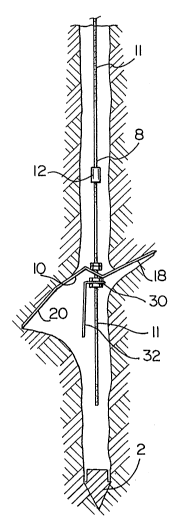Some of the information on this Web page has been provided by external sources. The Government of Canada is not responsible for the accuracy, reliability or currency of the information supplied by external sources. Users wishing to rely upon this information should consult directly with the source of the information. Content provided by external sources is not subject to official languages, privacy and accessibility requirements.
Any discrepancies in the text and image of the Claims and Abstract are due to differing posting times. Text of the Claims and Abstract are posted:
| (12) Patent Application: | (11) CA 2013773 |
|---|---|
| (54) English Title: | EARTH ANCHORING DEVICE |
| (54) French Title: | DISPOSITIF D'ANCRAGE AU SOL |
| Status: | Dead |
| (52) Canadian Patent Classification (CPC): |
|
|---|---|
| (51) International Patent Classification (IPC): |
|
| (72) Inventors : |
|
| (73) Owners : |
|
| (71) Applicants : |
|
| (74) Agent: | DUNSMUIR, GEORGE H. |
| (74) Associate agent: | |
| (45) Issued: | |
| (22) Filed Date: | 1990-04-03 |
| (41) Open to Public Inspection: | 1991-10-03 |
| Examination requested: | 1991-06-25 |
| Availability of licence: | N/A |
| (25) Language of filing: | English |
| Patent Cooperation Treaty (PCT): | No |
|---|
| (30) Application Priority Data: | None |
|---|
ABSTRACT OF THE DISCLOSURE
One form of conventional earth anchor device
includes an anchor which is driven into the ground as the
leading element of a combination. Thus, the anchor must be
streamlined to facilitate ground entry which is incompatible
with the need for a curved body facilitating anchoring.
Another problem is the need for anchors having large bearing
areas which require considerable effort for insertion into the
ground. A device providing a solution to these problems
includes a tube or sleeve with a sacrificial blade releasably
mounted in the bottom end thereof for driving into the ground,
and a rod carrying an anchor and a spring biasing the anchor
outwardly, whereby the sleeve can be driven into the ground,
following which the rod is held down while the sleeve is
extracted, leaving the blade, and, when the anchor and spring
exit the sleeve, the spring biases the anchor into a ground
engaging position. An upward pull on the rod pivots the
anchor into a secure anchoring position in the ground.
Note: Claims are shown in the official language in which they were submitted.
Note: Descriptions are shown in the official language in which they were submitted.

For a clearer understanding of the status of the application/patent presented on this page, the site Disclaimer , as well as the definitions for Patent , Administrative Status , Maintenance Fee and Payment History should be consulted.
| Title | Date |
|---|---|
| Forecasted Issue Date | Unavailable |
| (22) Filed | 1990-04-03 |
| Examination Requested | 1991-06-25 |
| (41) Open to Public Inspection | 1991-10-03 |
| Dead Application | 1994-10-03 |
There is no abandonment history.
| Fee Type | Anniversary Year | Due Date | Amount Paid | Paid Date |
|---|---|---|---|---|
| Application Fee | $0.00 | 1990-04-03 | ||
| Maintenance Fee - Application - New Act | 2 | 1992-04-03 | $50.00 | 1992-03-17 |
| Maintenance Fee - Application - New Act | 3 | 1993-04-05 | $50.00 | 1993-03-26 |
| Registration of a document - section 124 | $0.00 | 1994-01-07 |
Note: Records showing the ownership history in alphabetical order.
| Current Owners on Record |
|---|
| PILDYSH, MIKHAIL |
| ANCHOR ENVIRONMENTAL LTD. |
| Past Owners on Record |
|---|
| None |